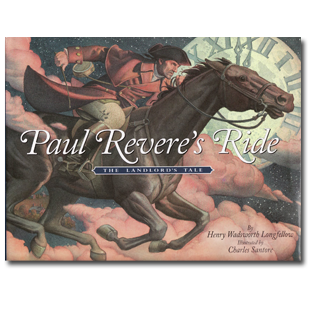
A FEW OTHER EVENTS FOR
APRIL 18:
- Happy birthday Mitchell Sharmat (Nate the Great series) and Barbara Reid (Fox Walked Alone).
- It’s the birth date of Evelyn Sibley Lampman (1907-1980), The Shy Stegosaurus of Cricket Creek.
- Happy birthday to the original Yankee Stadium, first opened in The Bronx, New York City, in 1923. The facility, known as “The House that Ruth Built” was demolished last year. Read Ballpark: The Story of America’s Baseball Fields by Lynn Curlee.
- In 1924 the first crossword puzzle book is published. Read The Puzzling World of Winston Breen and The Potato Chip Puzzles, both by Eric Berlin.
I must admit that today is truly one of my favorite holidays, if not my absolute favorite, of the year. Although I try to avoid being “Boston centric” in the Almanac, I have lived in or near the city for more than forty years. Writers often get told to write about what they know—and today the holiday I know and love is Patriots’ Day. For those more attuned to sports than history, you will probably recognize this local holiday as the running of the Boston Marathon. But for those who delight in the details of America’s hard-won independence as a nation, this day remains sacred: the beginning of the American Revolution. In years past I have awoken long before dawn to stand on the Lexington Green and watch British and American reenactors face each other in a reconstruction of the Battle of Lexington. Usually an all-you-can-eat pancake breakfast rounds out this engaging event.
Since April is also Poetry Month, the two events can be celebrated with one spectacular book, Paul Revere’s Ride: The Landlord’s Tale by Henry Wadsworth Longfellow, illustrated by Charles Santore. Certainly many of my older readers memorized Longfellow as part of their elementary school experience. Poetry has changed since this nineteenth-century classic, but to my ears these Longfellow lines bring back memories of devoted teachers: “Listen, my children, and you shall hear/Of the midnight ride of Paul Revere,/On the eighteenth of April, in Seventy-five;/Hardly a man is now alive/Who remembers that famous day and year.” Paul Revere waits for his signal in the old North Church, and then heads out to alert the citizens in the towns like Medford, Lexington, and Concord. He travels “To every Middlesex [Massachusetts County] village and farm” to deliver “the midnight message of Paul Revere.”
Many artists have illustrated Longfellow’s words, but in 2003 Philadelphia artist Charles Santore created a highly realistic version that shows the uniforms, faces, and landscapes in exact detail. If any American artist can be said to be the descendant of Howard Pyle, Santore would be chosen for this accolade. Certainly one of the finest realistic draftsman working in children’s books today, he knows how to render every nuance of a horse and rider in motion. Readers view the landscape in detail as Revere might have, and they move along in time with Longfellow’s stirring beat.
I know historians remind us that the British did capture Revere, and he did not ride alone. Longfellow re-created the spirit of the Revolution but missed some of its exact history. Fortunately, Santore has taken greater care with accuracy in his rendition of events.
So, if you aren’t able to join us for pancakes and celebrate Patriots’ Day in Massachusetts this year, you can at least feel you have been here and helped set the Revolution in motion if you pick up Paul Revere’s Ride.
Here’s a page from Paul Revere’s Ride:

Originally posted April 18, 2011. Updated for 2024.













Thanks so much for posting this. I’d forgotten how much I love this poem, the way its meter mimics the galloping of the horse. (Hope the pancakes were yummy!)
Thanks for shaing this on Patriots’ Day! I have always loved Longfellow’s poem despite the inaccuracies but Santore’s illustrations make me love the poem all the more. The illustrations really draw you into the history.
I remember encountering this in elementary school and trying to memorize the text. If memory serves, I memorized the first part. Now I cannot remember it, but I do remember how I felt about it. Thank you for the reminder!
It may be inaccurate, but that doesn’t change the memories I have of sitting on my grandmother’s lap in her overstuffed rocker while she read this poem to me. I loved it and thought it was enormously exciting, even though my 4 year old brain really didn’t understand the American Revolution.